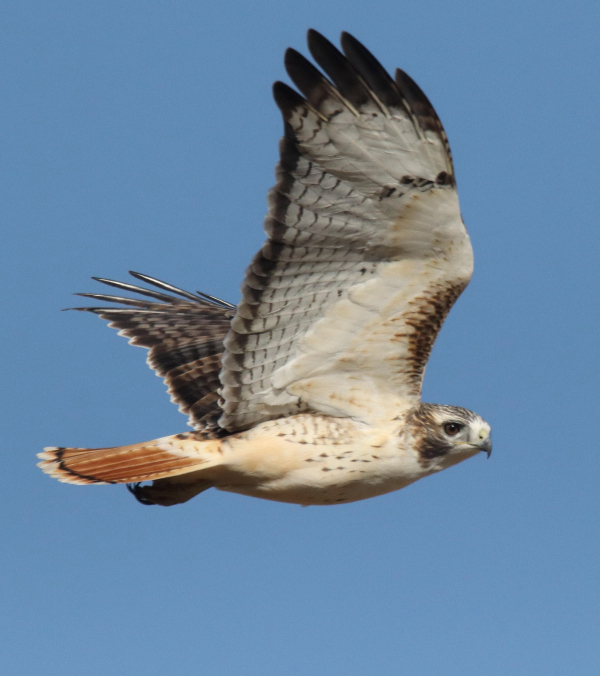
Red-tailed Hawks have become the most dominant raptors now, with similar numbers of Northern Harriers on the move.
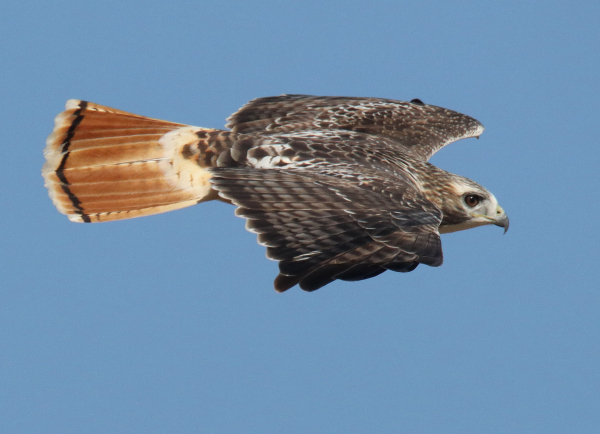
Gliding into the wind, the same Red-tail shows its aerodynamics as it rudders its colorful tail feathers in flight.
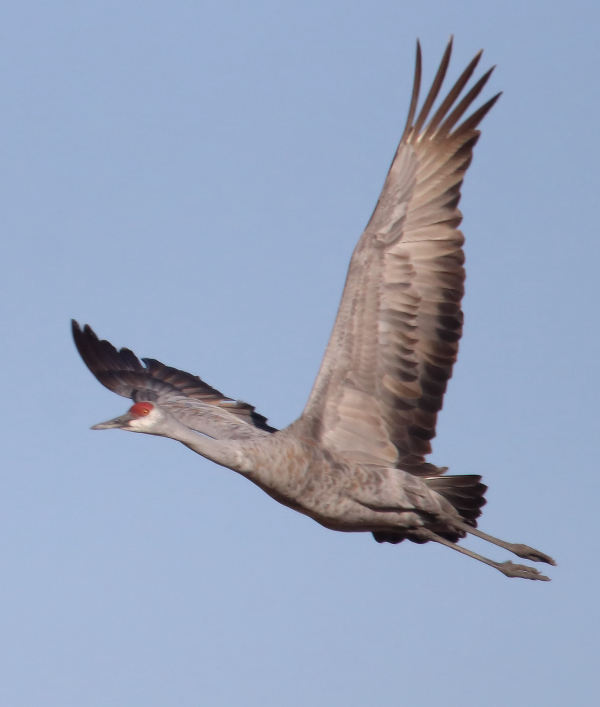
A rare lone Sandhill Crane flew close while distant flocks of Sandhills were active throughout the Long Lake area.
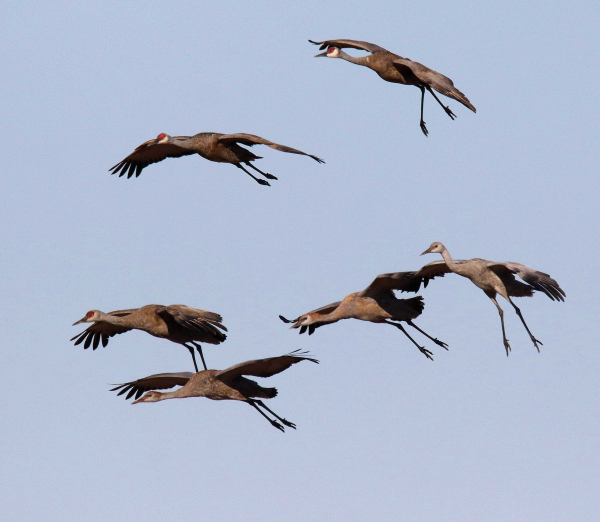
A flock of Sandhills begins parachuting to land among a larger feeding flock.
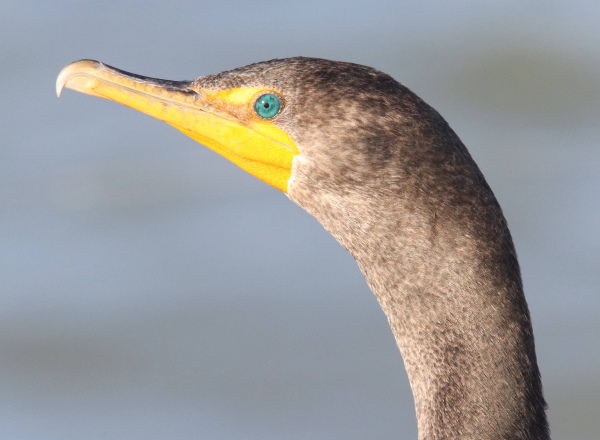
Seeming to hold an emerald gem in a setting of gold, this young Double-crested Cormorant provided a close portrait at Long Lake Refuge.

A Ring-necked Gull provided another aerodynamic flight photo as it approached on a fall wind.
|
Friday was a beautiful fall day with some trees showing peak colors, which coincided with my interest in checking back on the Tundra Swans at Cindy’s Lake, where I counted 76 swans the previous week. It was especially exciting to see that the swans increased by more than 2 times in the ensuing 4 days as I counted 167 swans in the massive lake, including many more pairs with gray-plumaged cygnets with them. Along the “raptor route” there were 20 birds of prey – 12 Northern Harriers and 8 Red-tailed Hawks, although a species I don’t often see outnumbered the raptors in a single flock of 22 Cattle Egrets.
Of course, there were many White Pelicans, Double-crested Cormorants, American Coots, and ducks ranging from Northern Pintails to Ruddy Ducks. I was quite surprised that when I returned within 2 miles of my office I sighted 4 American Avocets and about 70 Long-billed Dowitchers at Alice’s Marsh, but there were even more at Dean’s Lake, where I counted 16 avocets and estimated 180 dowitchers.
In my yard a nice fallout of Yellow-rumped Warblers was obvious outside my windows earlier Friday, and I wished I could get some nice photos of a warbler surrounded by colored leaves, but that’s much harder than it sounds (I’ll keep you posted). Saturday morning a few White-throated Sparrows stopped momentarily in my red sumacs, which provided evidence of another fallout, underlined by a small flock of Yellow-rumped Warblers, although a bigger migration was forecast for Saturday night according to BirdCast.
Sandhill Excitement
The promise of Sandhill Cranes lured me west to Long Lake National Wildlife with the hope of photographing the exceptional birds with wild calls that have echoed for millennia across North America. None showed at the marsh where I photographed 2 weeks before, and none were in the fields where hundreds fed before. But after a couple more miles a flock of Sandhills in flight pressed me forward, until I found just the right locale to position my mobile blind (car) for what now looked like an aerial trail as flocks were rising up to the south, crossing before me with the sun at my back, and landing in a wheat stubble field to the north. That’s when the fun began!
Just as I can’t get enough of photographing loons, I so enjoy photographing Sandhill Cranes, and Saturday afternoon I would have 3 opportunities to photograph non-stop flocks. It was immediately noticeable that among the flocks were more first-fall Sandhills on their first migration south. Few young of the year were present 2 weeks earlier at the end of September, but now pairs with young were much more abundant. Another interesting Sandhill change was that there were many flocks of cranes south of the largest refuge lake now. As always, I enjoyed the opportunity to photograph the lively cranes, and I share more photos in this week’s Bird Photography feature. Other birds at the refuge included big flocks of Northern Shovelers, along with some Lesser Scaup, Redheads, Ruddy Ducks, and Green-winged Teal. A large flock of Long-billed Dowitchers was present, but I didn’t see any avocets during this visit. Scattered Western Grebes were on hand, along with many American Pelicans, more Double-crested Cormorants, and lots of Ring-billed Gulls – plus 2 single male Ring-necked Pheasants.
On the way to Long Lake Refuge, there were a few flocks of Canada Geese numbering less than 50 each, and a small flock of 5 White-fronted Geese on the edge of a huge lake where 6 Tundra Swans were feeding. Rare in the open plains, a flock of at least 100 American Crows appeared to be migrating straight south. I also saw a flock of 4 Sharp-tailed Grouse and there were plenty of raptors, but just 2 species – 14 Red-tailed Hawks and 10 Northern Harriers.
Hummingbird Highlights
With my feeding station surrounded by yellow ash leaves on one side, red sumac leaves on the other, and green sumacs below, the view outside my 4 bay windows was the best of fall. Even so, my nectar feeder was being ignored; it seemed the young male Ruby-throated Hummingbird probably moved on. But wait, there was a hummingbird! From its actions alone I could tell this was a newbie as it was on high alert, stretching its neck high between quick tastes of nectar, and I confirmed that it was a female with a white neck and belly plumage.
She returned Thursday, and I didn’t give up on the young male that provided 10 days of action at my hummingbird feeder, but I didn’t see it Wednesday or Thursday. Yet a new young male Ruby-throat arrived Friday that showed much less color than the previous young male, and that fact was underlined by the appearance of the original young male. That made 3 Rugy-throated Hummingbirds, probably all young birds. The new male seemed to visit most often Friday, although I was only on hand a few hours Wednesday through Saturday during daylight hours.
But alas, with high hopes, Saturday there were no hummingbird sightings, and it now looks like the last day of this fall’s hummingbird season was Friday October 11th, far later than any previous fall sightings in my yard. Even so, I’ve been wrong a couple times before on predicting the last hummingbird of the season, so I’m keeping my nectar feeder stocked until freeze-up. A small consolation was a small flock of White-throated Sparrows that stopped momentarily among the red sumac leaves and yellow ash leaves, and another small flock of Yellow-rumped Warblers swept through an hour later.
Local Birding
More swans were present Sunday, this time much closer to my office – less than a mile northeast – at Dean’s Marsh where 11 Tundra Swans were resting near the west shore. That suggested I should check Meiers’ Lake, a swan hotspot located about 18 miles southwest, where I was kinda surprised to find 48 Tundra Swans on hand this early in the southwest bay of the huge lake. In the area was a mix of Gadwalls, Mallards, and Green-winged Teal. At Charo Marsh there were no swans, but there were 10 Long-billed Dowitchers, with a different mix of ducks – mostly Northern Pintails, 16 Canvasbacks, and some Lesser Scaup, Ruddy Ducks, and Green-winged Teal.
Monday began with a White-throated Sparrow landing among the golden leaves of the ash tree next to my feeding station, while another White-throat joined 2 Harris’s Sparrows, a Chipping Sparrow, and 6 Dark-eyed Juncos feeding on flower seeds in my backyard, but when I started my afternoon drive no juncos or sparrows were obvious during a search of the surrounding area. There were a few American Avocets at nearby Dean’s Marsh, 15 to be exact, and there were 2 other Avocets at Melody’s Marsh a half-mile south of my office. Two seemingly late Least Sandpipers were at Charo Marsh, along with 6 Long-billed Dowitchers and a lone Lesser Yellowlegs.
Two highlights of the day were a group of 16 Tundra Swans in a relatively small marsh adjacent to the Lost Road, where there were also many Canada Geese and Mallards. The other exciting observation was a flock of 14 Buffleheads, the first of fall. I hope you have plenty of highlights during your week, and wish you good luck to find new birds arriving in your area, and wherever you wander in the fall days ahead. It’s sure beautiful here, and I can almost hear the Minnesota woodlands calling me east among the vibrant colors there. Happy Fall Birding!
Article and Photos by Paul Konrad
Share your bird sightings and photographs at editorstbw2@gmail.com